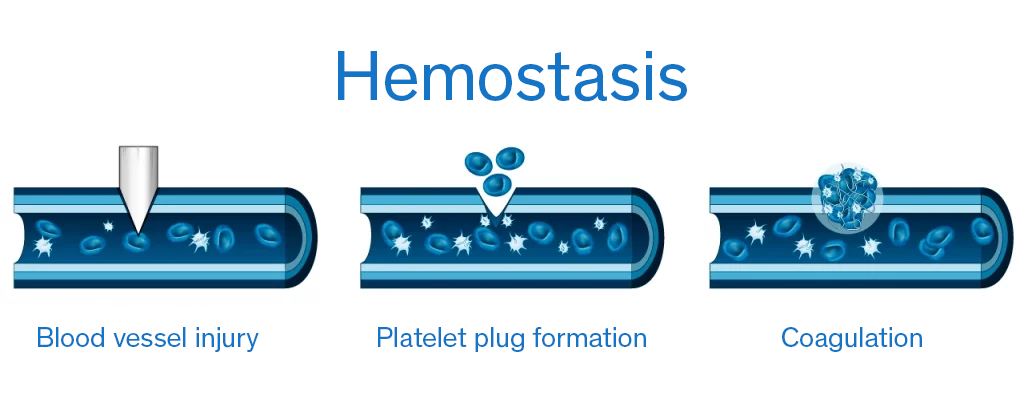Hemostasis refers to a series of organic functions that act as a defense mechanism in the body, helping prevent or stop internal or external bleeding.
What Is Hemostasis?
Hemostasis is the body’s ability to maintain blood within blood vessels when an injury occurs. It begins with platelet accumulation, the formation of blood clots to stop bleeding, and once the damage is repaired, the dissolution of the clots.
Hemostasis is divided into two main phases:
Primary Hemostasis
Primary hemostasis is the initial process that stops bleeding after a vascular injury by forming a platelet plug.
When a blood vessel ruptures, the damaged endothelium exposes subendothelial collagen, triggering platelet adhesion through specific receptors. This adhesion activates the platelets, causing them to change shape, release their granule contents, and recruit additional platelets to the site of injury.
The resulting platelet plug is temporary and fragile, but it is crucial for controlling bleeding immediately.
Primary hemostasis concludes as the secondary phase begins to reinforce the plug.
Secondary Hemostasis
Secondary hemostasis reinforces and stabilizes the platelet plug formed in the primary phase.
This phase is known as the coagulation cascade, a series of steps that lead to the formation of a blood clot. An insoluble fibrin mesh forms and weaves into the platelet plug, making the clot more resistant to mechanical forces from blood flow.
Coagulation Testing
The coagulation process involves various chemical reactions in which 13 known coagulation factors play a critical role. These convert fibrinogen (a soluble protein) into fibrin (an insoluble protein), which forms the structure of the clot.
Most proteins involved in blood coagulation are produced by vascular endothelial cells.
When the hemostatic process is abnormal, it’s usually due to platelet deficiency (thrombocytopenia),
Lack of specific coagulation factors or conditions such as:
- Hemophilia
- Von Willebrand disease
- Congenital deficiencies in coagulation factors
- Digestive disorders
- Viral infections
- Autoimmune diseases
- Use of anticoagulants
- Vitamin C deficiency
- Thrombocytopenia
- Hepatitis
- Cirrhosis
- Uremia
- Pregnancy
Hemostatic studies focus on platelet counts and prothrombin and thromboplastin times. These are typically ordered in cases such as:
- Recurrent bleeding
- Pulmonary thromboembolism
- Deep vein thrombosis
- Von Willebrand disease
Additionally, molecular testing of coagulation factors is necessary to identify any abnormalities that may predispose the patient to thrombosis.
At ABC Medical Center’s Internal Medicine area, we can provide you with specialized care. Contact us!
Fuentes:
Scielo, Cleveland Clinic, MSD Manuals


